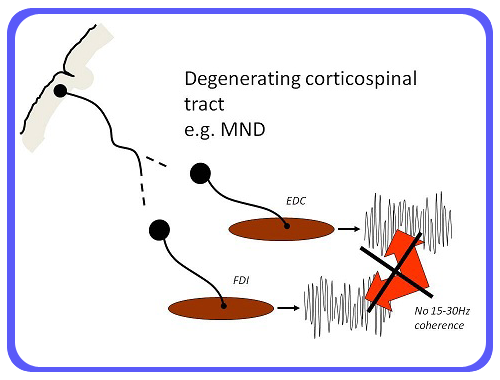Motor Neurone Disease (MND)
There are approximately 1,500 new cases of sporadic motor neurone disease (MND) a year in the UK. For the majority of these patients, MND is a rapidly disabling and fatal condition, with an average life expectancy of 2.5 years from diagnosis.
MND is a neurodegenerative disease characterized by the progressive loss of layer V motor cortical pyramidal neurons, corticospinal tract (CST) axons and alpha motoneurons, as shown in the figure below.

Although treatment is mainly supportive, there is good evidence that the neuroprotective agent riluzole prolongs survival in MND. Riluzole inhibits mechanisms of excitotoxic neuronal cell death, and slows the progression of MND by reducing the rate at which motoneurones die. Unfortunately, when patients become symptomatic there is already significant motoneuron loss in both symptomatic and asymptomatic muscles, and by the time most patients start neuroprotective therapy there is extensive irrecoverable motor neurone loss and disability. In the majority of MND patients therefore, because of the delay in diagnosis, the therapeutic window is missed. Although there are several reasons for this delay, one important reason is the limitations of diagnostic tests. While sensitive electrophysiological techniques for detecting alpha motoneuron degeneration are available (e.g. single unit EMG, Motor Unit Number Estimation) there is a dearth of sensitive tests of corticospinal tract (CST) disease. While some laboratories are looking at ways of improving the sensitivity of transcranial magnetic stimulation (TMS) as a test of CST disease, we are taking an entirely novel approach.
We have been investigating the role of 15-30Hz oscillations in motor control. As part of these experiments, lesion experiments in our lab have shown that 15-30Hz IMC is dependent on an intact CST (Reticulospinal Tract). When CST collaterals between motoneuron pools are intact there is significant 15-30Hz IMC as illustrated below.

However, if there is degeneration within the CST the motoneurone pools will not receive any synchronous 15-30Hz oscillatory input from the CST, and therefore significant 15-30Hz IMC will absent (see below).

We are now investigating whether 15-30Hz IMC can be applied as an electrodiagnostic test of CST disease, particularly in MND. We have already shown that significant 15-30Hz IMC is absent in patients with Primary Lateral Sclerosis, a rare variant of MND in which degenerative disease is mostly limited to the CST. We have also confirmed that IMC is not affected by the loss of alpha motoneurons because it is still present in patients with Progressive Muscular Atrophy, a form of MND in which degeneration is limited to alpha motoneurons for several years before the CST starts degenerating (see figure below).

We are now investigating the IMC in patients with Amyotrophic Lateral Sclerosis (ALS), the more common form of MND, in which patients present with a mixture of alpha motoneuron and CST disease from the outset, and in MND mimic syndromes.
People involved in this project
- Karen Fisher (PhD student)
- Dr Boubker Zaaimi (Post-doc)
- Dr Mark Baker
- Prof Stuart Baker
- Stephan Jaiser
- Dr Hanny Seow
- Dr Tim Williams
Sponsors of this study
Back to the Projects




